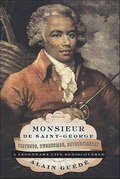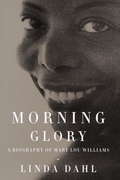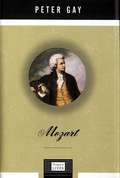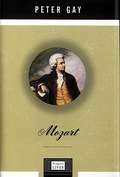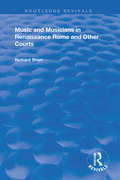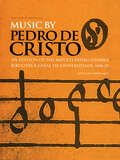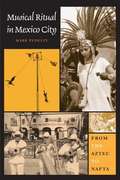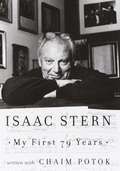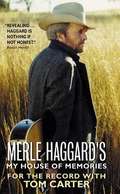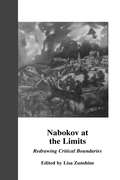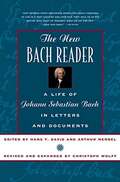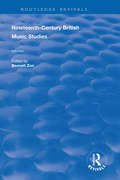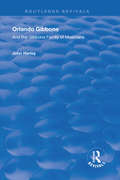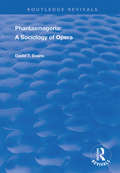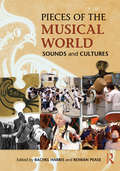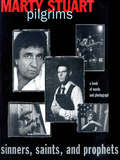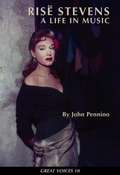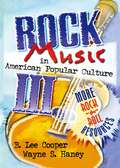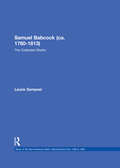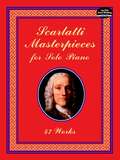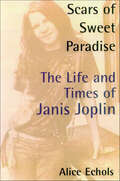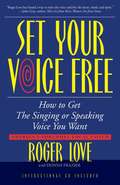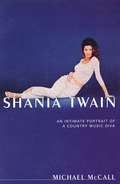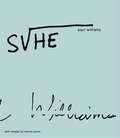- Table View
- List View
Monsieur de Saint-George: Virtuoso, Swordsman, Revolutionary: A Legendary Life Rediscovered
by Alain GuédéThe first full biography of one of the greatest figures of eighteenth-century Europe, known in his time as the "Black Mozart"Virtually forgotten until now, his life is the stuff of legend. Born in 1739 in Guadeloupe to a slave mother and a French noble father, he became the finest swordsman of his age, an insider at the doomed court of Louis XVI, and, most of all, a virtuosic musician. A violinist, he directed the Olympic Society of Concerts, which was considered the finest in Europe in an age of great musicians, including Haydn, from whom he commissioned a symphony, and Mozart, to whom he was often compared. He also became the first Freemason of color, embracing the French Revolution with the belief that it would end the racism against which-despite his illustrious achievements-he struggled his whole life. This is the life of Joseph Bologne, known variously as Monsieur de Saint-George, the "Black Mozart," and, because of his origins, "the American." Alain Guédé offers a fascinating account of this extraordinary individual, whose musical compositions are at long last being revived and whose story will never again be forgotten.
Morning Glory
by Linda DahlMary Lou Williams -- pianist, arranger, composer, and probably the most influential woman in the history of jazz -- receives the attention she has long deserved in the definitive biography by a leading scholar of women in jazz.The illegitimate child of an impoverished and indifferent mother, Williams began performing publicly at the age of seven when she became known admiringly in her native Pittsburgh as "the little piano girl of East Liberty," playing one day for the Mellons at bridge teas and the next in gambling dens where the hat was passed for change. She grew up with the jazz of the early part of the century, championed by the likes of Earl Hines and Fats Waller, yet unlike so many other musicians of her time, she was open to new forms in jazz -- she was an early champion of bop, and a mentor and colleague to its central figures, such as Thelonius Monk and Bud Powell -- and in broader musical styles as well (after her conversion to Catholicism, she wrote masses and other sacred music).Most of the other famous women in jazz -- Billie Holiday, Ella Fitzgerald -- have been singers. Williams was instead a phenomenal pianist who performed solo, with small groups and big bands, in vaudeville and clubs, and on numerous records. But she is equally well known today as a composer and arranger of remarkable versatility and power, having worked with, among others, Duke Ellington and Benny Goodman. Her compositions have been recorded by artisits as varied as Marian McPartland, Dizzy Gillespie, Nat "King" Cole, Sarah Vaughan, Ella Fitzgerald, and herself -- and, more recently, by cutting-edge players Geri Allen and Dave Douglas.But Williams was more than "just a musician"; her interests were catholic in both senses, and she struggled to combine her love of music with her love of God. She was a tireless humanitarian, and made ongoing attempts to help dozens of down-and-out musicians; in the 1950s, her apartment was, at times, virtually a rehab. Though she was often in emotional despair, she found comfort for her many disappointments and hurts not only in her music but in her spirituality.Linda Dahl, granted unprecedented access to the large Williams archive, has given us the whole of Williams's very full life, from her often harrowing days on the road to her tumultuous marriages and love affairs, from the ups and downs of her unique fifty-year career to the remarkable spirituality that came to inform both her daily life and her music. This is a striking protrait of one of our least understood and most important musicians.
Mozart: A Life
by Peter GayMozart's short life (only 35 years) were astoundingly productive. This book tells the story of his life, and provides useful information about his major compositions and associations. There are more comprehensive biographies of Mozart, but this one is not a difficult book to read and will provide enough information to augment the experience of listening to his amazing music.
Mozart: A Life (Grandes Figures, Grandes Signatures Ser.)
by Peter GayA biography of the greatest musical mind in Western history Mozart's unshakable hold on the public's consciousness can only be strengthened by historian and biographer Peter Gay's concise and deft look at the genius's life. Mozart traces the development of the man whose life was a whirlwind of achievement, and the composer who pushed every instrument to its limit and every genre of classical music into new realms. .
Music and Musicians in Renaissance Rome and Other Courts (Routledge Revivals)
by Richard SherrFirst published in 1999, the essays that follow have been selected from the author’s writings to explore musical institutions in 15th and 16th century Italy with a detailed focus on the papal choir, but with additional comments on Mantua (Mantova), Florence and France. Much of the material which formed the basis of those essays was largely drawn from archives. Richard Sherr explores diverse areas including the Medici coat of arms in a motet for Leo X, performance practice in the papal chapel during the 16th century, the publications of Guglielmo Gonzaga, Lorenzo de’ Medici as a patron of music and homosexuality in late sixteenth-century Italy.
Music by Pedro de Cristo (Music Archive Publications #Vol. 1)
by Owen ReesFirst Published in 1999. Routledge is an imprint of Taylor & Francis, an informa company.
Musical Ritual in Mexico City: From the Aztec to NAFTA
by Mark PedeltyOn the Zócalo, the main square of Mexico City, Mexico's entire musical history is performed every day. "Mexica" percussionists drum and dance to the music of Aztec rituals on the open plaza. Inside the Metropolitan Cathedral, choristers sing colonial villancicos. Outside the National Palace, the Mexican army marching band plays the "Himno Nacional," a vestige of the nineteenth century. And all around the square, people listen to the contemporary sounds of pop, rock, and música grupera. In all, some seven centuries of music maintain a living presence in the modern city. This book offers an up-to-date, comprehensive history and ethnography of musical rituals in the world's largest city. Mark Pedelty details the dominant musical rites of the Aztec, colonial, national, revolutionary, modern, and contemporary eras, analyzing the role that musical ritual played in governance, resistance, and social change. His approach is twofold. Historical chapters describe the rituals and their functions, while ethnographic chapters explore how these musical forms continue to resonate in contemporary Mexican society. As a whole, the book provides a living record of cultural continuity, change, and vitality.
My First 79 Years
by Chaim Potok Isaac SternRenowned violinist Isaac Stern shares both his personal and his artistic experiences -- the story of his rise to eminence, his feelings about music and the violin, his rich emotional life, his great friendships and collaborations with colleagues such as Leonard Bernstein and Pablo Casals, his background as an ardent supporter of Israel, and his ideas and beliefs about art, life, love, and the world we live in. He and writer Chaim Potok spent a year talking and sharing their perceptions, and as a result, Stern's voice comes through persuasively as the musician and humanitarian loved and admired worldwide.
My House of Memories (For the Record with Tom Carter)
by Tom Carter Merle HaggardIn this riveting personal story, the award-winning, bestselling recording artist takes you on a tour through his house of memories, offering a fascinating look inside his turbulent and successful life. Merle reveals previously untold stories about his birth and troubled upbringing in a converted railroad boxcar. He recalls the loss of his father when he was nine, and how his childish disobedience transformed into full-blown delinquency that landed him behind the cold walls of San Quentin. Having lived a life shaped by violence, gambling, and drugs, he shares the lessons he learned and how he continues to pay for decades of reckless living. He pays tribute to his mother, and relives the painful memory of her death. And he talks about the music he loves, and how it has ultimately defined the man he is.
Nabokov at the Limits: Redrawing Critical Boundaries (Border Crossings)
by Lisa ZunshineThe eleven contributors to this volume investigate the connections between Nabokov's output and the fields of painting, music, and ballet.
New Bach Reader
by David Wolfe Hans T. David Mendel"Just reading these documents brings this great composer to life in a most exciting and vivid way. I love this book!" ―Yo-Yo Ma Through hundreds of letters, family papers, anecdotes, and records, the Bach Reader established a new approach to biography by offering original documents in impeccable translations. In The New Bach Reader, Christoph Wolff has incorporated numerous facsimiles and added many newly discovered items, reflecting the current state of scholarship about the composer's life and music. The readings in this volume provide an accurate and vivid picture of Bach's world and of his far-reaching influence.
Nineteenth-Century British Music Studies: Volume 1 (Routledge Revivals)
by Bennett ZonOriginally published in 1999, this volume of essays arises from the first biennial Music in Nineteenth-Century Britain conference, held at the University of hull in July 1997. Like the conference, this book seeks to expand and reassess our current knowledge of musical life in Britain during the nineteenth century, as well as to challenge the preconceptions of earlier attitudes and scholarship. This volume covers a cohesive range of subjects and materials intended not only as a revision of past views and scholarship, but also as a tool for further research. It provides a vigorous reconsideration of the musical activity of the period.
Orlando Gibbons and the Gibbons Family of Musicians (Routledge Revivals)
by John HarleyFirst published in 1999, this volume is the first full-length study to deal with the life and music of Orlando Gibbons since E.H. Fellowes’s short book, originally published in 1923. John Harley investigates in detail the family and musical background from which Orlando Gibbons emerged, and gives a fascinating account of the activities of his father, William Gibbons, as a wait in Oxford and Cambridge. He traces, too, the activities of Orlando’s brothers – Edward, who was the master of the choristers at King’s College, Cambridge and later at Exeter Cathedral; Ferdinando, who may have taken over from his father as head of the Cambridge waits, and who became a wait in Lincoln; and Ellis, who contributed two madrigals to Thomas Morley’s collection of 1601, The Triumphs of Oriana. Attention naturally focuses principally on Orlando Gibbons. A full record is given of his remarkably youthful appointment as an organist of the Chapel Royal (he was probably less than twenty at the time) and of his life at court. His additional appointments as one of Prince Charles’s musicians and as organist of Westminster Abbey are also described, as is his sudden and premature death in his early forties. Gibbons’s music is carefully examined in a series of chapters dealing with his pieces for keyboard and for viols, his songs, his full and verse anthems, and his works for the Anglican liturgy. His development as a composer within these genres is followed, and the character of particular pieces is considered. John Harley concludes that whereas, at one time, Gibbons ‘tended to be admired as a successor to Tallis and Byrd, working in a style not essentially different from theirs’, it is now ‘easier to view him as a pioneer, whose work was cut short by his untimely death’. Orlando Gibbons’s son Christopher was only a child when his father died, but he became one of the foremost composers and keyboard players of his generation, writing and performing chamber works and music for the stage during the Commonwealth. Following the Restoration of King Charles II, Christopher Gibbons gained his father’s former posts at the Chapel Royal and Westminster Abbey, for which establishments he wrote a number of anthems. His importance is recognized by the inclusion of a long chapter on his life and works.
Perspectives on American Music since 1950 (Essays in American Music)
by James R. HeintzeAs the century comes to a close, composition of music in the United States has reached little consensus in terms of style, techniques, or schools. In fourteen original articles, the contributors to this volume explore the broad range and diversity of post-World War II musical culture. Classical and jazz idioms are both covered, as is the broad history of electronic music in the United States.
Phantasmagoria: Sociology of Opera (Routledge Revivals)
by David T. EvansFirst published in 1999, this original and entertaining sociological study takes a comprehensive and critical view of opera as unique cultural artefact as loss making ‘industry’, as institution with a ‘museum’ culture, and as consumed commodity of rare distinction and elaborate ritual. Specific chapters deal with opera within the contexts of musicological analysis, auratic art and fetishized taste: opera as business and as ‘museum’: singers’ opera: producers’ opera and audiences’ opera. There is also a chapter on ‘opera’: popular, commercialised fragments of opera outside the opera house, consumed by and through all manner of reproduced means: CD, video, Three Tenors concerts: film and TV soundtracks: advertising jingles etc. Despite the supposed popularisation and successful commercial exploitation of ‘opera’ during the past decade or so, this study concludes that opera remains an art-form, institution and ritual of relative inaccessibility and exclusiveness. The commercial interest in and profitability of ‘opera’ do not translate into new ‘popular’ audiences in the opera house. The increased dependency of opera companies on corporate funding in the face of retreating government subsidies may have brought a new ‘elite’ audience into the expensive seats, pandered to by the introduction of surtitles etc., but the traditional ‘elite’ has succeeded in closing down entry to opera in other select venues where opera continues to confirm and maintain their select identity and prestige of their life-style.
Pieces of the Musical World: Sounds and Cultures
by Rachel Harris Rowan PeasePieces of the Musical World: Sounds and Cultures is a fieldwork-based ethnomusicology textbook that introduces a series of musical worlds each through a single "piece." It focuses on a musical sound or object that provides a springboard from which to tell a story about a particular geographic region, introducing key aspects of the cultures in which it is embedded, contexts of performance, the musicians who create or perform it, the journeys it has travelled, and its changing meanings. A collaborative venture by staff and research ethnomusicologists associated with the Department of Music at SOAS, University of London, Pieces of the Musical World is organized thematically. Three broad themes: "Place", "Spirituality" and "Movement" help teachers to connect contemporary issues in ethnomusicology, including soundscape studies, music and the environment, the politics of identity, diaspora and globalization, and music and the body. Each of the book's fourteen chapters highlights a single musical "piece" broadly defined, spanning the range of "traditional," "popular", "classical" and "contemporary" musics, and even sounds which might be considered "not music." Primary sources and a web site hosting recordings with interactive listening guides, a glossary of musical terms and interviews all help to create a unique and dynamic learning experience of our musical world.
Pilgrims: Sinners, Saints, and Prophets
by Marty StuartMarty Stuart, one of the most popular country artists, portrays well-known and not-so-well-known pilgrims through spectacular photographs and well-written words. Marty portrays in the book "a life that ain't easy, but one that I understand".
Risë Stevens: A Life in Music (Great Voices #10)
by John PenninoRisë Stevens (1913-2013) was a force of nature on the stage. From her humble beginnings in New York, Stevens'talent, determination and heart helped her rise up to perform on the greatest stages all over the world. Whether she was on the radio, up on the screen, or stunning audiences at the Met, her vocal presence was unforgettable. But in Carmen, Risë Stevens ascended to the level of legendary performers. The author, John Pennino, documents her amazing life, struggles and achievements. He also includes a detailed chronology and discography, and a CD of rare recordings. This book deals briefly with her post-operatic career.
Rock Music in American Popular Culture III: More Rock 'n' Roll Resources
by Frank Hoffmann B Lee Cooper Wayne S HaneyRock Music in American Popular Culture III: More Rock ’n’Roll Resources explores the fascinating world of rock music and examines how this medium functions as an expression of cultural and social identity. This nostalgic guide explores the meanings and messages behind some of the most popular rock ’n’roll songs that captured the American spirit, mirrored society, and reflected events in our history. Arranged by themes, Rock Music in American Popular Culture III examines a variety of social and cultural topics with related songs, such as: sex and censorship--“Only the Good Die Young” by Billy Joel and “Night Moves” by Bob Seger and The Silver Bullet Band holiday songs--“Rockin’Around the Christmas Tree” by Brenda Lee and “The Christmas Song” by Nat King Cole death--“Leader of the Pack” by The Shangri-Las and “The Unknown Soldier” by The Doors foolish behavior--“When a Man Loves a Woman” by Percy Sledge and “What Kind of Fool” by Barbra Streisand and Barry Gibb jobs and the workplace--“Don’t Stand So Close to Me” by The Police and “Dirty Laundry” by Don Henley military involvements--“Boogie Woogie Bugle Boy” by the Andrews Sisters and “War” by Edwin Starr novelty recordings--“The Purple People Eater” by Sheb Wooley and “Eat It” by Weird Al Yankovic letters and postal images--“P. S. I Love You” by The Beatles and “Return to Sender” by Elvis PreselyIn addition, a discography and a bibliography after each section give further examples of the themes and resources being discussed, as do extensive lists of print references at the end of the text.
Samuel Babcock: The Collected Works (Music of the New American Nation: Sacred Music from 1780 to 1820)
by Laurie J. SampselFirst Published in 1999. Routledge is an imprint of Taylor & Francis, an informa company.
Scarlatti Masterpieces for Solo Piano: 47 Works (Dover Classical Piano Music)
by Domenico ScarlattiBorn in the same year as Johann Sebastian Bach, Domenico Scarlatti strongly influenced subsequent trends in keyboard music through his uniquely elegant, embellished, fleet virtuoso style. This new compilation of popular selections by the great master presents favorites drawn from his more than 500 miniature sonatas.All of Scarlatti's familiar and best-loved masterpieces -- well-known worldwide from piano recitals and CDs -- appear here: tarantellas, Siciliennes, pastorals, and sparkling high-speed keyboard toccatas of the greatest ingenuity.According to legendary keyboard artist Wanda Landowska, "when we hear Scarlatti's music, we know that we are in the climate of sunlight and warmth. It is Italy, it is Spain -- the spirit of the Latin countries and the god of the Mediterranean." Pianists and all music lovers can discover the truth of that statement in this handsome and inexpensive compilation of exquisite pieces.
Scars of Sweet Paradise: The Life and Times of Janis Joplin
by Alice EcholsJanis Joplin was the skyrocket chick of the sixties, the woman who broke into the boys' club of rock and out of the stifling good-girl femininity of postwar America. With her incredible wall-of-sound vocals, Joplin was the voice of a generation, and when she OD'd on heroin in October 1970, a generation's dreams crashed and burned with her. Alice Echols pushes past the legary Joplin-the red-hot mama of her own invention-as well as the familiar portrait of the screwed-up star victimized by the era she symbolized, to examine the roots of Joplin's muscianship and explore a generation's experiment with high-risk living and the terrible price it exacted.A deeply affecting biography of one of America's most brilliant and tormented stars, Scars of Sweet Paradise is also a vivid and incisive cultural history of an era that changed the world for us all.
Set Your Voice Free
by Roger Love Donna FrazierInternationally acclaimed for his work as a vocal coach to a wide range of top recording artists and celebrities -- among them Eminem, Wilson Phillips, Smashing Pumpkins, Al Jarreau, the Beach Boys, Phish, Billy Idol, Tyra Banks, Billy Baldwin, Alicia Silverstone, and many others -- Roger Love has pioneered a technique that effectively connects speakers and singers to parts of their voice they've never used before. Whether your goal is to carry a tune, expand your vocal range, or speak with ease and confidence before an audience, Roger Love provides you with exactly the help you need. Through the innovative techniques and enjoyable exercises in this book and accompanying CD, Love demonstrates how you can strengthen your "middle voice" and navigate smoothly through several octaves without pressure or strain. Set Your Voice Free holds the key to vocal success and satisfaction -- it's like professional voice lessons in book form.
Shania Twain
by Michael MccallShania Twain is not your average pop star. She has mega-hits like "You're Still the One", multi-platinum albums (Come on Over)...but she's much more than merely the sum of her success. Growing up in rural Canada amidst great poverty. Shania spent summers working for her father in a reforestation crew, learning how to handle an axe and wield a chainsaw as well as any man. At age 21, both her parents were killed in a magic car crash, and she was left to raise three younger siblings alone. The discipline and diligence she was forced to learn was then turned to her music career, with astounding results. From the cover of Rolling Stone to Country America, this cross-over wonder has charmed millions of music lovers around the world, and her fan base continues to grow Here, finally, is her whole story, complete with never-before-seen photos and insider information. This is the book Shania fans have been waiting for.
She
by Saul WilliamsHailed as "a dreadlocked dervish of words...the Bob Marley of American poets" (Esquire), Saul Williams is a gifted young poet who is opening up this literary art form to a new generation of readers. Like his writing -- a fearless mix of connecting rhythms and vibrant images -- Saul Williams is unstoppable. He received raves for his performance as an imprisoned street poet in the Trimark Pictures release Slam, winner of the Camera d'Or at Cannes and the Grand Jury prize at the 1998 Sundance Film Festival. The consummate spoken-word performance artist, Williams has also been signed by producer Rick Rubin to record a CD of his poetry.She is a fascinating and unique collection of interconnected poems by this multi-talented star -- and marks the beginning of an incredible and totally original artistic career.
